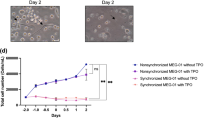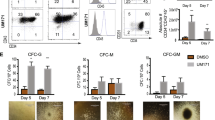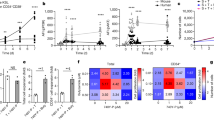Abstract
Hematopoiesis is a complex process of regulated cellular proliferation and differentiation from the primitive stem cells to the final fully differentiated cell. The long and extensive search for a factor specifically regulating megakaryocytopoiesis led to the cloning of a hormone, here called thrombopoietin (TPO), that specifically promotes proliferation and differentiation of the megakaryocytic lineage. The availability of recombinant TPO and its imminent clinical use has made a more detailed understanding of its effects on hematopoietic cells more urgent. Normal megakaryocyto- and thrombopoiesis occurs predominantly in the bone marrow, a difficult organ to study in situ, particularly in humans, due to the low numbers of megakaryocytic progenitors and the consequent difficult isolation as pure populations. Thus, we developed an in vitro system which may allow us to address questions regarding the biology of TPO. The acute myeloid leukemia (AML)-derived cell lines HU-3, M-07e, M-MOK and TF-1 have absolute dependence on granulocyte–macrophage colony-stimulating factor (GM-CSF). We cultured these cells long term (>6 months) in the continuous presence of TPO (omitting GM-CSF). TPO alone supported the maintenance and expansion of these sister cell lines, HU-3/TPO, M-07e/TPO, M-MOK/TPO and TF-1/TPO, that displayed somewhat longer doubling times, a larger cell size, and a higher percentage of polynucleated giant cells and slightly adherent cells than the corresponding countercultures grown with GM-CSF. In the absence of TPO the cells died quickly, within a few days; thus, the TPO-grown cell lines have an absolute dependence on this factor, but could all be switched back to growth with GM-CSF. In comparison with the GM-CSF-treated cells, the receptors for GM-CSF and interleukin-3 (IL-3) were down-regulated and the receptors for stem cell factor (SCF) and TPO were up-regulated in the TPO-exposed cells. A short-term proliferation assay showed a stronger response of the TPO-cell lines to erythropoietin, GM-CSF, IL-3, PIXY-321, SCF and TPO than the GM-CSF-cell lines. Flow cytometric analysis of the GM-CSF- and TPO-cultured lines displayed an up-regulation of the megakaryocytic surface markers CD41, CD42 and CD61, and a down-regulation of the erythroid marker glycophorin A in the latter cell lines, suggesting some differentiation along the megakaryocytic lineage. Thus, in long-term exposure, TPO appears to have both a proliferative and a differentiative effect on responsive cells. Under serum-deprived culture conditions, TPO acted as a survival factor on the TPO-cell lines. Taken together, these findings indicate that the TPO-dependent cell lines represent important biological reagents for further characterization of the biology of TPO and should also provide a great aid for future in vitro experiments aimed at elucidating megakaryocyto- and thrombopoiesis.
This is a preview of subscription content, access via your institution
Access options
Subscribe to this journal
Receive 12 print issues and online access
$259.00 per year
only $21.58 per issue
Buy this article
- Purchase on Springer Link
- Instant access to full article PDF
Prices may be subject to local taxes which are calculated during checkout
Similar content being viewed by others
Author information
Authors and Affiliations
Rights and permissions
About this article
Cite this article
Drexler, H., Zaborski, M. & Quentmeier, H. Thrombopoietin supports the continuous growth of cytokine-dependent human leukemia cell lines. Leukemia 11, 541–551 (1997). https://doi.org/10.1038/sj.leu.2400621
Received:
Accepted:
Issue Date:
DOI: https://doi.org/10.1038/sj.leu.2400621



